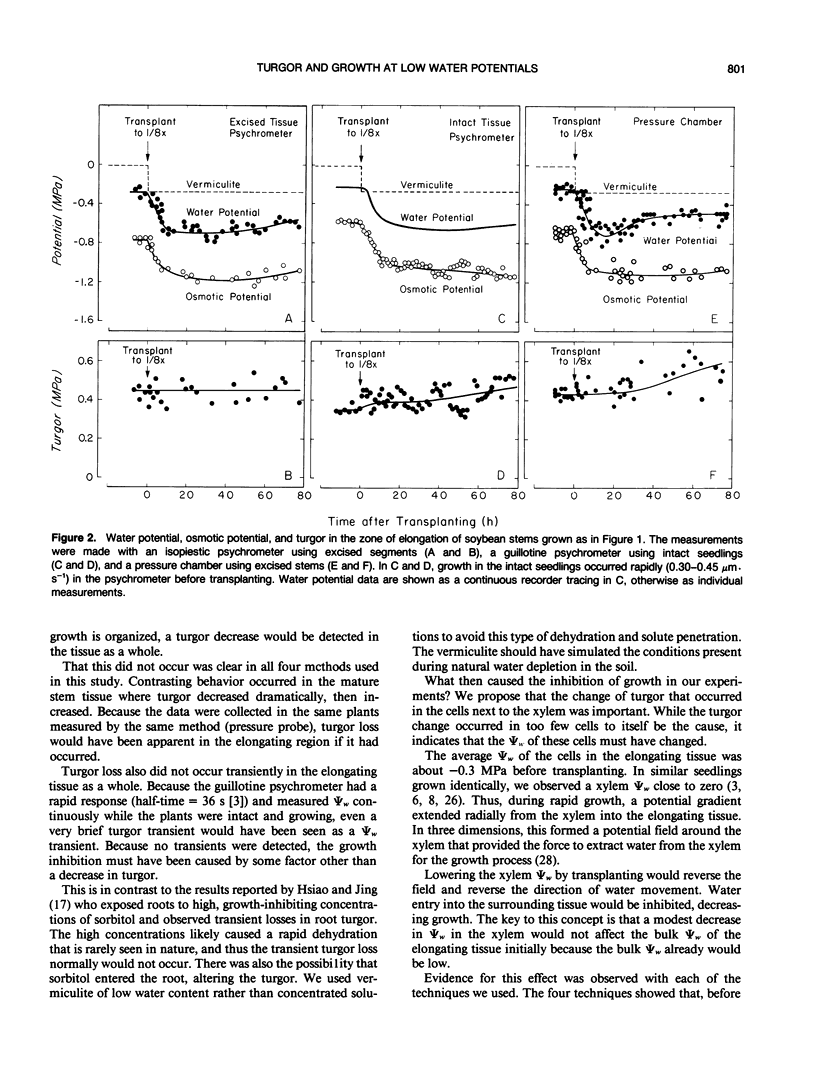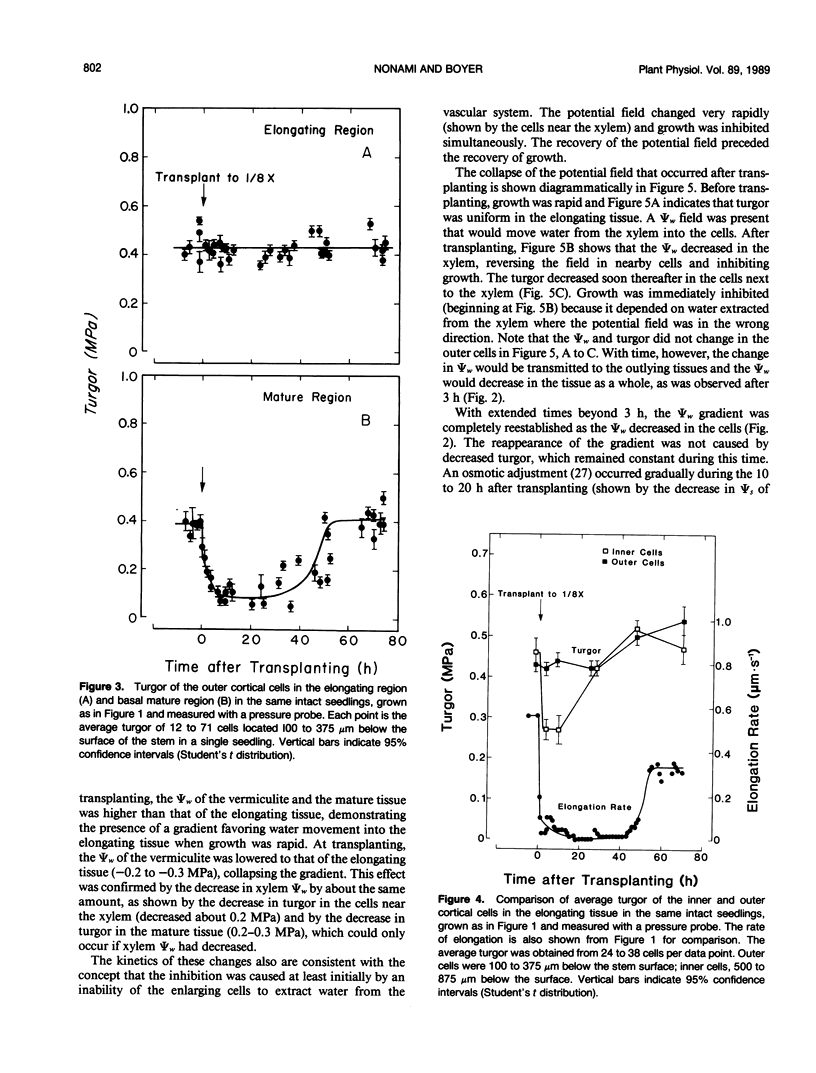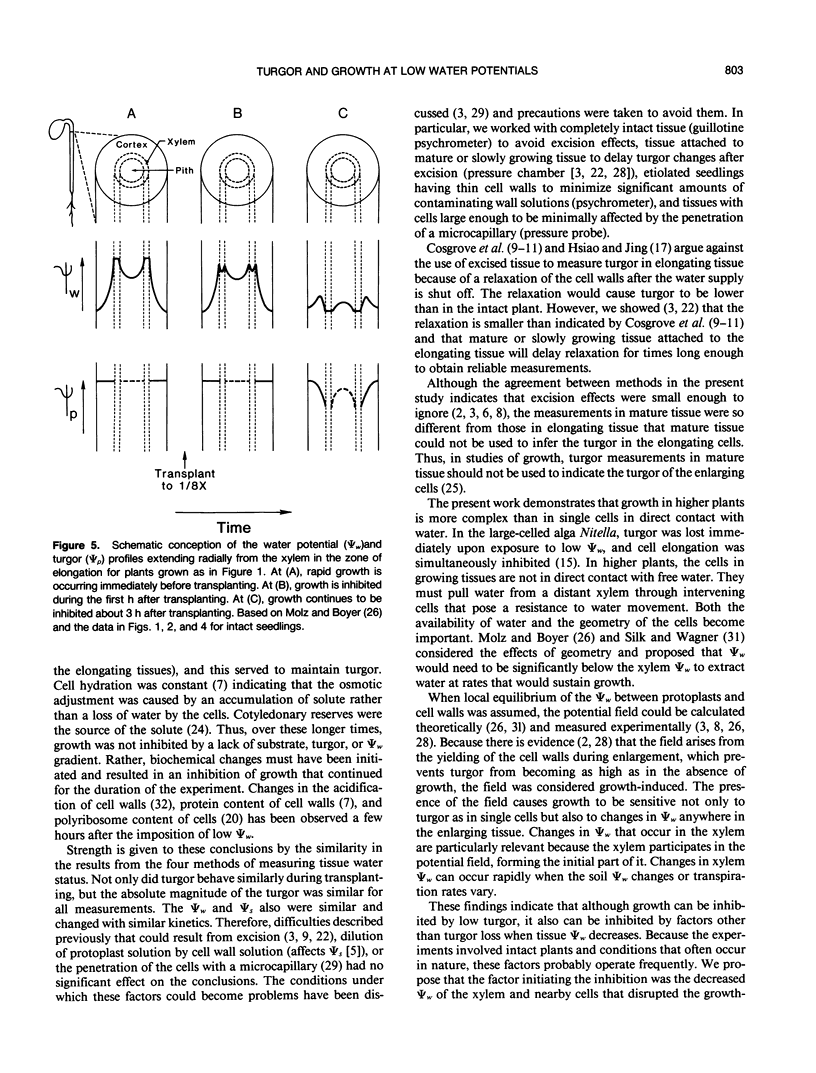Abstract
Turgor affects cell enlargement but has not been measured in enlarging tissue of intact plants when growth is inhibited by inadequate water. Mature or excised tissue can be problematic for these measurements because turgor may not be the same as in intact enlarging cells. Therefore, we measured the average turgor in the elongating region of intact stems of soybean (Glycine max [L.] Merr.) while the seedlings were exposed to low water potentials by transplanting to vermiculite of low water content. Stem growth was completely inhibited by the transplanting, and the average turgor decreased in the mature stem tissue. However, it did not decrease in the elongating region whether measured in intact or excised tissue (total of four methods). At the cellular level, turgor was uniform in the elongating tissue except at transplanting, when turgor decreased in a small number of cortical cells near the xylem. The reduced turgor in these cells, but constant turgor in most of the cells, confirmed that no general turgor loss had occurred but indicated that gradients in water potential extending from the xylem into the enlarging tissue were reduced, thus decreasing the movement of water into the tissue for cell enlargement. A modest growth recovery occurred after 2 days and was preceded by a recovery of the gradient. This suggests that under these conditions, growth initially was inhibited not by turgor loss but by a collapse of the water potential gradient necessary for the growth process.
Full text
PDF






Selected References
These references are in PubMed. This may not be the complete list of references from this article.
- Boyer J. S. Leaf water potentials measured with a pressure chamber. Plant Physiol. 1967 Jan;42(1):133–137. doi: 10.1104/pp.42.1.133. [DOI] [PMC free article] [PubMed] [Google Scholar]
- Boyer J. S., Potter J. R. Chloroplast response to low leaf water potentials: I. Role of turgor. Plant Physiol. 1973 Jun;51(6):989–992. doi: 10.1104/pp.51.6.989. [DOI] [PMC free article] [PubMed] [Google Scholar]
- Boyer J. S. Relationship of water potential to growth of leaves. Plant Physiol. 1968 Jul;43(7):1056–1062. doi: 10.1104/pp.43.7.1056. [DOI] [PMC free article] [PubMed] [Google Scholar]
- Bozarth C. S., Mullet J. E., Boyer J. S. Cell wall proteins at low water potentials. Plant Physiol. 1987 Sep;85(1):261–267. doi: 10.1104/pp.85.1.261. [DOI] [PMC free article] [PubMed] [Google Scholar]
- Cavalieri A. J., Boyer J. S. Water potentials induced by growth in soybean hypocotyls. Plant Physiol. 1982 Feb;69(2):492–496. doi: 10.1104/pp.69.2.492. [DOI] [PMC free article] [PubMed] [Google Scholar]
- Cosgrove D. J. Cell wall yield properties of growing tissue : evaluation by in vivo stress relaxation. Plant Physiol. 1985 Jun;78(2):347–356. doi: 10.1104/pp.78.2.347. [DOI] [PMC free article] [PubMed] [Google Scholar]
- Cosgrove D. J., Van Volkenburgh E., Cleland R. E. Stress relaxation of cell walls and the yield threshold for growth: demonstration and measurement by micro-pressure probe and psychrometer techniques. Planta. 1984;162(1):46–54. doi: 10.1007/BF00397420. [DOI] [PubMed] [Google Scholar]
- Cosgrove D. J. Wall relaxation in growing stems: comparison of four species and assessment of measurement techniques. Planta. 1987;171:266–278. [PubMed] [Google Scholar]
- Cutler J. M., Steponkus P. L., Wach M. J., Shahan K. W. Dynamic aspects and enhancement of leaf elongation in rice. Plant Physiol. 1980 Jul;66(1):147–152. doi: 10.1104/pp.66.1.147. [DOI] [PMC free article] [PubMed] [Google Scholar]
- Greacen E. L., Oh J. S. Physics of root growth. Nat New Biol. 1972 Jan 5;235(53):24–25. doi: 10.1038/newbio235024a0. [DOI] [PubMed] [Google Scholar]
- Green P. B., Erickson R. O., Buggy J. Metabolic and physical control of cell elongation rate: in vivo studies in nitella. Plant Physiol. 1971 Mar;47(3):423–430. doi: 10.1104/pp.47.3.423. [DOI] [PMC free article] [PubMed] [Google Scholar]
- Hüsken D., Steudle E., Zimmermann U. Pressure probe technique for measuring water relations of cells in higher plants. Plant Physiol. 1978 Feb;61(2):158–163. doi: 10.1104/pp.61.2.158. [DOI] [PMC free article] [PubMed] [Google Scholar]
- Kutschera U., Briggs W. R. Growth, in vivo extensibility, and tissue tension in developing pea internodes. Plant Physiol. 1988 Jan;86(1):306–311. doi: 10.1104/pp.86.1.306. [DOI] [PMC free article] [PubMed] [Google Scholar]
- Matsuda K., Riazi A. Stress-induced osmotic adjustment in growing regions of barley leaves. Plant Physiol. 1981 Sep;68(3):571–576. doi: 10.1104/pp.68.3.571. [DOI] [PMC free article] [PubMed] [Google Scholar]
- Matyssek R., Maruyama S., Boyer J. S. Rapid wall relaxation in elongating tissues. Plant Physiol. 1988 Apr;86(4):1163–1167. doi: 10.1104/pp.86.4.1163. [DOI] [PMC free article] [PubMed] [Google Scholar]
- Michelena V. A., Boyer J. S. Complete turgor maintenance at low water potentials in the elongating region of maize leaves. Plant Physiol. 1982 May;69(5):1145–1149. doi: 10.1104/pp.69.5.1145. [DOI] [PMC free article] [PubMed] [Google Scholar]
- Molz F. J. Growth-induced Water Potentials in Plant Cells and Tissues. Plant Physiol. 1978 Sep;62(3):423–429. doi: 10.1104/pp.62.3.423. [DOI] [PMC free article] [PubMed] [Google Scholar]
- Nonami H., Boyer J. S. Origin of growth-induced water potential : solute concentration is low in apoplast of enlarging tissues. Plant Physiol. 1987 Mar;83(3):596–601. doi: 10.1104/pp.83.3.596. [DOI] [PMC free article] [PubMed] [Google Scholar]
- Nonami H., Boyer J. S., Steudle E. Pressure probe and isopiestic psychrometer measure similar turgor. Plant Physiol. 1987 Mar;83(3):592–595. doi: 10.1104/pp.83.3.592. [DOI] [PMC free article] [PubMed] [Google Scholar]
- Scholander P. F., Bradstreet E. D., Hemmingsen E. A., Hammel H. T. Sap Pressure in Vascular Plants: Negative hydrostatic pressure can be measured in plants. Science. 1965 Apr 16;148(3668):339–346. doi: 10.1126/science.148.3668.339. [DOI] [PubMed] [Google Scholar]
- Silk W. K., Wagner K. K. Growth-sustaining Water Potential Distributions in the Primary Corn Root: A NONCOMPARTMENTED CONTINUUM MODEL. Plant Physiol. 1980 Nov;66(5):859–863. doi: 10.1104/pp.66.5.859. [DOI] [PMC free article] [PubMed] [Google Scholar]
- Twente J. W., Twente J. A. Regulation of hibernating periods by temperature. Proc Natl Acad Sci U S A. 1965 Oct;54(4):1044–1051. [PMC free article] [PubMed] [Google Scholar]
- Van Volkenburgh E., Boyer J. S. Inhibitory effects of water deficit on maize leaf elongation. Plant Physiol. 1985 Jan;77(1):190–194. doi: 10.1104/pp.77.1.190. [DOI] [PMC free article] [PubMed] [Google Scholar]


